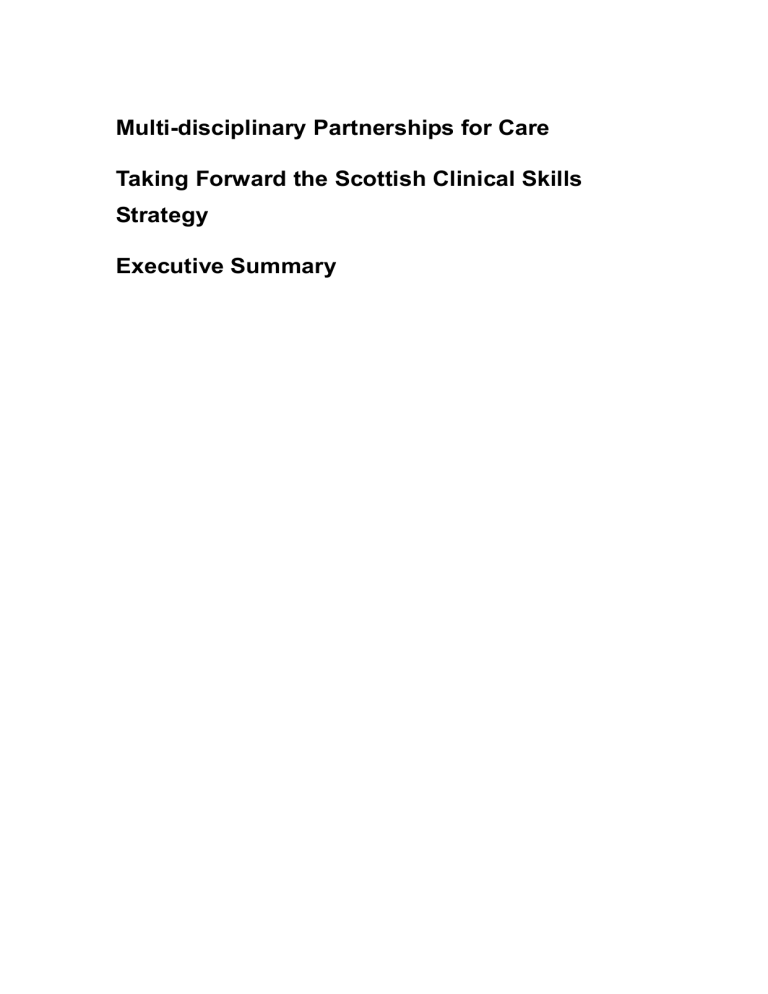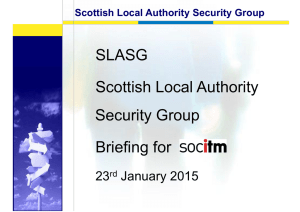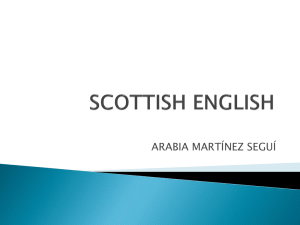Taking Forward the Scottish Clinical Skills Strategy

Multi-disciplinary Partnerships for Care
Taking Forward the Scottish Clinical Skills
Strategy
Executive Summary
Contents
1. Introduction _______________________________________________ 3
1.1 Multiprofessional access __________________________________ 3
1.2 Consistency of standards__________________________________ 3
1.3 Geographical access _____________________________________ 4
1.4 Supporting skills training in remote and rural Scotland ___________ 5
2. Aims and Vision for the Future ________________________________ 6
3. Strategy development _______________________________________ 9
3.1 Changes in the delivery of healthcare _______________________ 10
3.2 Review of clinical skills facilities ____________________________ 10
3.3 The use of simulation in healthcare education _________________ 11
4. Strategy implementation ____________________________________ 13
4.1 Scottish Clinical Skills Alliance _____________________________ 13
4.2 Managed Educational Network ____________________________ 13
4.3 NES Programme Board __________________________________ 14
4.4 Pilot study of a Mobile Unit _______________________________ 14
5. Impact of Strategy _________________________________________ 15
6. Conclusion_______________________________________________ 16
Introduction
This paper summarises the development of the Scottish Clinical Skills
Strategy.
It has been developed in response to the expectations set out in Building a
Health Service Fit for the Future (2005) and the discussion document Better
Health, Better Care (2007) to support workforce development in Scotland.
With a first class workforce we can deliver a first class sustainable health service which has patient safety and patient experience at its core. The implementation of the Strategy will provide a co-ordinated, efficient approach to clinical skills education delivering added value, both in terms of care and invested resources, to the people of Scotland.
Clinical skills training in Scotland is currently provided by NHS Boards and by
Higher Education Institutes and has until now developed in a piecemeal and haphazard manner without appropriate strategic planning.
1.1 Multiprofessional access
There are specialised centres of international excellence serving certain student and staff groups but there is often duplication of effort and investment.
The provision of core technical skills in other areas is very restricted with relatively little capital or recurrent investment. This has resulted in certain professional groups having to rely on skills being acquired through either short-term placements or training courses away from their local clinical setting which has a resultant impact on patient care.
1.2 Consistency of standards
There is a lack of consistent standards of clinical skills education across the
Service and Higher Education Institutes. Students and staff from different professional backgrounds and in different health board regions are being taught the same skills to different educational and clinical standards. They are also taught different sets of clinical skills for similar NHS posts. Recognition for skills training in these circumstances is often not transferable between
regions, and does not provide the staff with accreditation towards their personal and/or educational development.
Scottish Clinical Simulation Centre at Stirling Royal Infirmary.
1.3 Geographical access
There is currently no consistent geographical access to clinical skills education throughout Scotland with clusters of units in some areas and none in others.
Access to a specialist clinical skills unit is necessary for certain components of core training, but for highly specialised skills education which is required infrequently by small numbers of staff there is not the same requirement for local access. With the development of new roles, it will become increasingly necessary for advanced practitioner training to be made available to other staff groups. There is currently some duplication and a lack of co-ordination between training providers, which will be lessened and improved through the introduction of the Scottish Clinical Skills Strategy.
1.4 Supporting skills training in remote and rural Scotland
Depending upon the definition used, up to one in five people in Scotland live in remote and rural areas and there is clear policy intent to develop a framework of care that addresses the needs of these communities. The
Scottish Clinical Skills Strategy will support local healthcare practitioners, especially GPs, pharmacists and community health teams. The development of GPs and those with special interests has been identified as a specific need for skills education.
Building a Health Service Fit for the Future (2005) describes a fundamental shift in ways of working to ensure care is quicker, more personal and closer to home. The key drivers for this change include: i) The composition and skills of the workforce as the major determinants of how the Service is able to respond to changes in demand. ii) Information and communications technology tools which will fundamentally reshape how healthcare is delivered. iii) The provision of safe and sustainable services to support healthcare in remote and rural communities by:
Extending primary care, ensuring that services can be safely delivered in rural areas;
Providing a resilient system to address urgent care;
Utilising rural general hospitals and Community Health
Partnerships.
The skills and competences of the rural workforce need to be maintained to meet the requirements of up-to-date, safe and sustainable services.
2 Aims and Vision for the Future
In consultation with all the relevant stakeholders over a two-year period, the following aims for a Scottish Clinical Skills Strategy were agreed:
For Scotland to become a leading player in quality assured clinical skills education in both the UK and internationally.
For consistent standards for clinical skills education to be practised safely to meet clinical diagnostic and governance requirements.
The vision for the future of clinical skills education as a result of the consultation process can be summarised as follows:
Collaboration of all major stakeholders is required;
Enhanced Quality Standards of skills being practised in all healthcare settings;
Research and Development should be a priority;
A commitment to multi-professional education opportunities should be supported;
Skills training and the use of simulation should be integrated into core educational programmes and curricula;
Integration of skills training into a national accreditation framework is required;
Best value for money will be achieved through a managed network.
Four priority actions have been identified to take forward the vision for the
Scottish Clinical Skills Strategy, namely the:
Establishment of a Scottish Clinical Skills Alliance;
Establishment of a Managed Educational Network;
Establishment of a NHS Education for Scotland (NES) Programme
Board to performance manage NES financed • clinical skills units and prioritise future developments; and
A pilot study to evaluate a mobile unit for delivering simulation-based skills training in remote and rural settings.
2nd year nursing students, using the ‘SimMan’ Advanced Human Patient
Simulator (AHPS) to practise cardiac arrest management skills in the simulated A&E Resuscitation Room at University Campus, Hamilton.
A local Brownie troup practising resuscitation techniques on a child manikin in the Clinical Skills Centre at Aberdeen Royal Infirmary, in preparation for their
First Aid Badge (permission to reproduce the image has been obtained).
3.0 Strategy development
Building a Health Service Fit for the Future (2005) placed an emphasis on collaboration, co-operation and partnership. The report also stressed reducing inequality, providing more local treatment, improving patient safety, and developing new clinical roles.
In 2005 and 2006 NES held a series of meetings with key stakeholders (from the public, different healthcare practitioners and clinical skills education experts) to assess the current strengths and weaknesses of clinical skills training. The key issues raised were as follows:
The need to enhance patient safety and reduce clinical errors, against the backdrop of adverse events and potential litigation;
Changes in patient population and limited population bases in some areas;
Increased focus on maximising effective use of financial resources through designing out duplication in the current skills training;
The importance of ‘buy in’ from all stakeholders involved in training and clinical practice;
Inequality/variability of access to dedicated skills units.
The key priorities in developing a Scottish Clinical Skills Strategy were to address issues of access; to ensure that clinical skills training in Scotland responded to the needs of the NHS in Scotland; and to achieve best value for the substantial sums of money already invested in clinical skills training by both NHS Boards and Higher Education Institutes. An effective clinical skills strategy has the potential to: improve the patient experience (use of evidencebased simulation); improve patient safety (as can be evidenced from high reliability organisations with an effective safety culture); and to make a significant contribution to reducing adverse events.
3.1 Changes in the delivery of healthcare
Patient expectations and experiences of healthcare are changing. Patients expect quicker and easier access to NHS services, and appropriate individualised treatment that meets their needs.
Changes in clinical practice have meant that many patients having surgical or invasive procedures spend less time in hospital, resulting in a reduced availability of patients for traditional bedside teaching. Equally, those patients who have longer admissions for intensive or specialised treatment tend to be sicker and less appropriate for involvement in training.
Clinical skills training is also needed to equip staff with the skills they need to take on new roles under service redesign. Similarly, staff will need to be able to demonstrate maintenance of skills. Maximising the educational opportunities in clinical skills units will also help address the problem of reduced training time but has to be seen as a component of a managed educational process based around outcomes and feedback.
3.2 Review of clinical skills facilities
Clinical Skills are defined as any action, performed by an NHSScotland employee involved in direct patient care, which impacts on clinical outcome in a measurable way. These include:
Cognitive or ‘thinking’ skills (such as clinical reasoning and decisionmaking);
Non-technical skills (such as team-working and communication);
Technical skills (such as clinical examination and invasive procedures).
Academic evidence to support improvements in clinical decision-making has grown in recent years. Health professional skills education has traditionally concentrated on technical ability, but it is increasingly recognised that there must be a focus on learning the cognitive processes to support safe clinical practice. A summary of the available evidence has concluded that rehearsing
team-work in a simulated environment could significantly reduce adverse events in healthcare.
Clinical skills units provide a realistic but safe environment which can help practitioners move from theory to practice, from novice to expert, without risk to the patient. There are already many good examples in Scotland of such developments including the Clinical and Surgical Skills Centres in Dundee, the Scottish Simulation Centre in Stirling, University Campus, Hamilton
(formerly Bell College), Robert Gordon University in Aberdeen and the Dental and Clinical Skills Unit at the Westburn Centre in Aberdeen. Such units can train staff to develop skills in technical and invasive procedures, examination and prescribing skills, communication, team-working and non-technical skills.
One of the main advantages of such training is that it gives immediate feedback on performance.
3.3 The use of simulation in healthcare education
The clinical skills required to communicate with and care for patients as a member of a healthcare team have traditionally been taught during supervised practice in clinical placements. The inevitable consequence of such an apprenticeship-based model is that students and junior staff have to practise and develop their skills from an early stage on patients undergoing treatment in clinical settings.
A major consequence of the drive for improved safety has been the introduction of simulation-based education techniques to complement more traditional supervised clinical teaching. In addition to the potential to reduce clinical errors, the use of simulation-based training is essential to achieve the reduced working hours, extended role development, appropriate training for low frequency clinical events and the skills maintenance required as the
Health Service is redesigned.
Simulation techniques reproduce a realistic clinical setting for educational purposes. They require the use of simulated patients (volunteers or actors), manikins (ranging from simple models to highly complex, computer controlled,
whole-body examples), computer-generated simulations or use of biological material.
There are strong parallels with a variety of ‘high risk’ industries where simulation-based training is an essential educational component for both technical and non-technical skills (such as team-working, communication and decision-making) driven by the need to maximise customer safety and experience.
There is also evidence from both health and airline industries that simulation techniques, when integrated into a managed educational process, are effective at promoting learning and skills acquisition and maintenance. The unique contribution of a simulated educational process is that students and practitioners can learn from errors in a safe, learner-centred educational environment. Skills can be developed through repeated practise and dedicated educational support within a multi-disciplinary team, without risk to patients.
This suggests that improved patient outcomes are to be expected through the increased use of simulated environments for multi-professional skills education.
Medical students learning cardiac examination on the Harvey simulator in the
Clinical Skills Area, Wolfson Medical School Building, University of Glasgow.
4.0 Strategy implementation
The successful implementation of the Strategy is dependent on four key developments.
4.1 Scottish Clinical Skills Alliance
A Scottish Clinical Skills Alliance will be established consisting of the relevant educational, funding, quality standard setting and service stakeholders, patient and public interest groups. It will be empowered by the Scottish
Government to ensure compliance with the high level principles of equity of access and value for money.
4.2 Managed Educational Network
A Managed Educational Network will be established to enable the delivery of clinical skills training across Scotland in order to provide:
Clinical leadership;
Common quality standards;
Increased training provision;
Co-ordination of Research and Development priorities;
Synergy with the National Patient Safety Alliance launched in March
2007.
The ideas behind the Managed Educational Network have been directly informed by emerging government policy related to the establishment of managed clinical networks. The National Clinical Lead will be supported by local clinical champions to provide the clinical and educational leadership to facilitate the collaborative working required. Priorities for the development of consistent skills will also be linked to the health priorities aligned to the discussion document Better Health, Better Care (2007) . A Research and
Development programme to develop the educational resources required to keep Scotland at the forefront of clinical skills training over the next five years, will be planned and co-ordinated through the Network. This will ensure that local practitioners have the clinical skills to provide safe and caring healthcare
encompassing common multi-professional standards which can be linked to national competency frameworks.
4.3 NES Programme Board
A Clinical Skills Programme Board will be established by NES to performance manage centrally funded national clinical skills units/services and to prioritise future developments in highly specialised skills. There will be a direct link to the Managed Educational Network to ensure a national co-ordinated approach to skills education.
4.4 Pilot study of a Mobile Unit
A mobile skills unit will be piloted and evaluated to assess its efficiency in delivering clinical skills training in remote and rural areas.
5 Impact of Strategy
The Managed Educational Network will develop specific indicators to assess the progress of the Strategy in achieving the priority outcomes:
The combination of multi-professional skills education through the increased use of simulation techniques, an • increased focus on cognition, and the factors which lead to adverse events, will provide an improved patient experience;
Improved geographical access to skills education will contribute to a decrease in health inequalities;
The Managed Educational Network will lead to a more effective use of available resources for skills education;
The combination of the above, whilst multi-factorial, will have a positive effect on health outcomes for patients in Scotland.
6 Conclusion
The Scottish Clinical Skills Strategy will be implemented over the next three years with joint funding from NES and the Scottish Funding Council. It has the potential through its four areas of action to enable Scotland to have a highly skilled NHS workforce who have equal access to skills education which will enhance patient experience and safety.
Further copies of this document are available, on request, from Beverley
Beasant.
Please call: 01382 496 359
Multi-disciplinary
Postgraduate Medical Office (Level 7)
Ninewells Hospital and Medical School
Dundee
DD1 9SY
Email: beverley.beasant@nes.scot.nhs.uk www.nes.scot.nhs.uk








